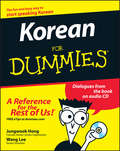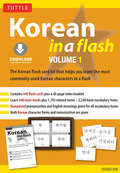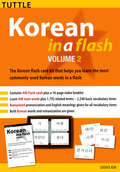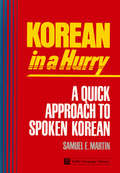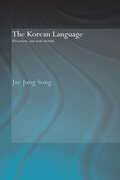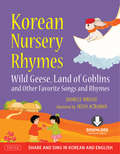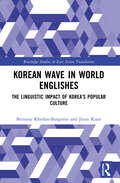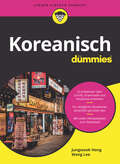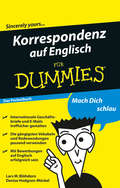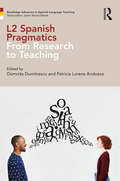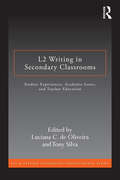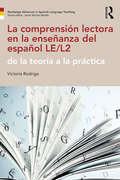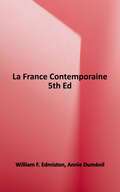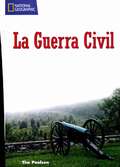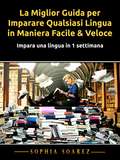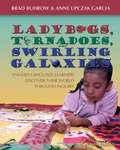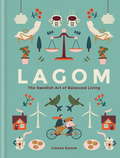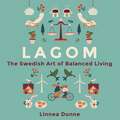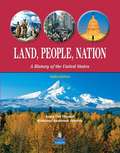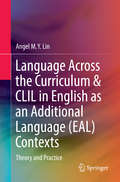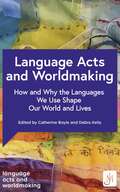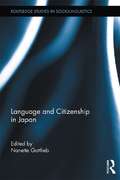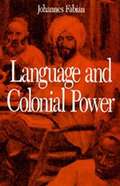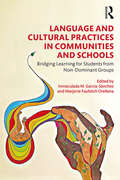- Table View
- List View
Korean For Dummies
by Jungwook Hong Wang LeeStart speaking Korean the fun and easy way with Korean For Dummies, a no-nonsense guide to Korean culture and the basics of Korean language. Pick up basic phrases and commonly used words so that you can converse with Koreans in both business and personal situations. You'll learn Korean for everyday life and task-specific expressions for Korean on the go. In addition, you'll discover important and fascinating aspects of Korean culture.This handy guide won't burden you with lists of grammar rules; just look up the phrases and cultural phrases that you need or read through the whole book for a general overview. You'll be able to place material in a daily context with cultural tidbits, phonetic spelling of Korean words, and the recorded Korean dialogues on the accompanying CD. Exercises will jog your memory and reinforce everything that you learn. Find out how to:Use basic phrases and words correctlyConverse intelligently about Korean cultureDo business with a Korean companySay task-specific expressionsPronounce Korean wordsPut material in a real-world contextMake a good first impression with KoreansComplete with lists of ten ways to learn Korean quickly, ten phrases to make you sound Korean, ten expressions that Koreans like to use, and ten things you should never do around a Korean, Korean For Dummies is your one-stop guide to speaking basic Korean and understanding the fundamentals of Korean culture.
Korean in a Flash Kit Volume 1
by Soohee KimKorean in a Flash Volume 1 is an excellent new language learning resource for travelers and others who want to learn Korean quickly and easily.<P><P>Part of the bestselling Tuttle In a Flash series, this complete boxed set of Korean character flash cards aids in recognition, vocabulary learning, review and self-testing. Korean in a Flash has a full range of features to help beginners and intermediate learners alike. Flash cards feature the most commonly used Korean words and phrases. Sample sentences in Korean are provided, along with related terms, frequently-used expressions and extended vocabulary. Contains 448 flash cards plus a 48 page index booklet. Learn 448 main words plus 1,792 related terms and 2,240 basic vocabulary items.Romanized pronunciation and English meanings given for all vocabulary items. Both Korean character forms and romanization are given.
Korean in a Flash Volume 2
by Soohee KimKorean in a Flash Volume 2 continues the learning-tool advantage for people interested in learning Korean quickly and easily.<P><P>This complete boxed set of flash cards has a full range of acclaimed features to help beginners and intermediate learners, and covers the second most-basic Korean words, plus related terms and phrases--in a flash! Contains 448 flash cards plus a 48 page index booklet. Learn 448 main words plus 1,792 related terms and 2,240 basic vocabulary items. Romanized pronunciation and English meanings given for all vocabulary items. Both Korean character forms and romanization are given.
Korean in a Hurry: A Quick Approach to Spoken Korean
by Samuel E. MartinThis is a useful manual of the Korean language. These lessons have been devised to facilitate easy language study and are conversationally applicable as soon as you learn them. This book has been printed in a handy pocket-size format.
The Korean Language: Structure, Use and Context
by Jae Jung SongSuitable for students of all levels, this book provides a general description of the Korean language by highlighting important structural aspects whilst keeping technical details to a minimum. By examining the Korean language in its geographical, historical, social and cultural context the reader is able to gain a good understanding of its speakers and the environment in which it is used. The book covers a range of topics on Korean including its genetic affiliation, historical development, sound patterns, writing systems, vocabulary, grammar and discourse. The text is designed to be accessible, primarily to English-speaking learners of Korean and scholars working in disciplines other than linguistics, as well as serving as a useful introduction for general linguists. The book complements Korean language textbooks used in the classroom and will be welcomed not only by readers with a wider interest in Korean studies, but also by Asian specialists in general.
Korean Nursery Rhymes
by Danielle Wright Helen AcramanA charming collection of fourteen well-loved rhymes, Korean Nursery Rhymes is the perfect introduction to Korean language and culture for young readers.This beautifully illustrated book features songs and rhymes perfect for children who are interested in learning the Korean language or about its culture. Presented in both English and Korean, this multicultural children's book also includes an audio CD with recordings of kids singing in both languages -- songs so lively and sweet, you'll soon find yourself singing along! Many accompany everyday play activities like jum rope and hand clap games. Others speak to a child's view of nature, and a love of home.Favorite rhymes and songs include: Little One Monkey's Bottom Twirling Round Spring in My Hometown And more!For preschoolers and beyond, this book will be a joy to the mind, the eye, the ear and the heart.
Korean Wave in World Englishes: The Linguistic Impact of Korea's Popular Culture
by Brittany Khedun-Burgoine Jieun KiaerThis book examines the linguistic impact of the Korean Wave on World Englishes, demonstrating that the K-Wave is not only a phenomenon of popular culture, but also language. The "Korean Wave" is a neologism that was coined during the 1990s that includes K-pop, K-dramas, K-film, K-food, and K-beauty, and in recent years it has peaked in global popularity. This book intends to show how social media phenomena have facilitated the growth of Korea’s cultural influence globally and enabled a number of Korean origin words to settle in varieties of Englishes. This in turn has globalised Korean origin words and revolutionised the English language through an active and collaborative process of lexical migration. Korean origin words such as oppa (older brother) are no longer bound solely to Korean-speaking contexts. The study focuses primarily on media content, particularly social media, corroborated by case studies to examine how linguistic innovation has been engendered by the Korean Wave. Suitable for students and researchers of Korean linguistics, Korean culture, Korean popular culture, and translation studies, this book is the first detailed study of the global linguistic impact of the Korean Wave.
Koreanisch für Dummies (Für Dummies)
by Jungwook Hong Wang LeeKorea erscheint uns Deutschen so fremd und unverständlich wie faszinierend - und das nicht erst seit K-Pop. Dieses Buch bietet Lesern eine grundlegende Einführung in die koreanische Sprache und Kultur: Angefangen beim Schriftsystem und der Aussprache über Grundlagen zu Grammatik und Vokabular bis hin zu einfachem Small Talk. Der Fokus liegt dabei auf der praktischen Anwendbarkeit: Alle Lektionen werden direkt anhand von praktischen Situationen eingeübt. Ein Buch für alle, die ihre neuen Koreanisch-Kenntnisse von Anfang an in die Praxis umsetzen möchten.
Korrespondenz auf Englisch fur Dummies Das Pocketbuch (Für Dummies)
by Dr. Lars M. Blöhdorn Denise Hodgson-MöckelHaben Sie häufiger mit englischsprachigen Kunden oder Kollegen zu tun? Oder wollen sich auf Englisch bewerben? Lars M. Blöhdorn und Denise Hodgson-Möckel geben Ihnen die wichtigsten Wörter und Formulierungen an die Hand. Von der richtigen Anrede und dem korrekten Aufbau von Angeboten, Reklamationen oder Einladungen über E-Mail-Etikette bis zur englischsprachigen Bewerbung für Ihren Traumjob finden Sie hier alles Wichtige für eine freundliche und verständliche Korrespondenz auf Englisch.
L2 Spanish Pragmatics: From Research to Teaching (Routledge Advances in Spanish Language Teaching)
by Domnita Dumitrescu Patricia Lorena AnduezaL2 Spanish Pragmatics is a comprehensive, state-of-the-art overview of current research into pragmatics and Spanish language teaching. It presents the research on the teaching of pragmatics and Spanish language as a multifaceted discipline. Written by an international cohort of scholars, the breadth of topics includes innovative topics in the teaching of Spanish, such as genre analysis, discourse markers, politeness and impoliteness, nonverbal communication, irony, and humor, as well as web-based pragmatics resources. Key features: An overview of new trends in Spanish pragmatics research and the growing need for instruction in intercultural communication; Insights derived from important theoretical and empirical works that may contribute to integrate pragmatics in the teaching of the language; Explanations with great clarity, plenty of examples and references, as well as connections to language teaching and learning; Tasks and activities that can help teachers move from a traditional curricular approach to a more innovative and engaging one; Descriptions of numerous activities or guidelines for the classroom, supplemented with additional materials; A bilingual glossary of terms in pragmatics that will help teachers in their implementation of activities to teach L2 Spanish pragmatics. L2 Spanish Pragmatics constitutes a reference book on current research on learning and teaching Spanish pragmatics. It will be of interest to university lecturers, researchers, and graduate students. It will also be an excellent resource for language educators and K-16 teachers willing to expand their knowledge and apply the teaching of pragmatics as an integral component in the teaching of the Spanish language.
L2 Writing in Secondary Classrooms: Student Experiences, Academic Issues, and Teacher Education (ESL & Applied Linguistics Professional Series)
by Luciana C. de Oliveira Tony SilvaSecond language writers and the teaching of writing at the secondary level have received little attention compared with other skills such as reading. Addressing this gap, this volume uniquely looks at both adolescent L2 writing and the preparation of secondary teachers to work with this population of students. Part I, on adolescent L2 writers, includes case studies looking at their literacy identities, their trajectories in mainstream content area classes, and their transition from high school to college. Part II looks at academic issues. The focus in Part III is L2 writing teacher education. Taking a theoretically eclectic approach that can support a variety of pedagogies, this book contributes significantly to understanding adolescent second language writers and to educating teachers to address these students’ specific needs.
La comprensión lectora en la enseñanza del español LE/L2: de la teoría a la práctica
by Victoria RodrigoLa comprensión lectora en la enseñanza del español LE/L2: de la teoría a la práctica presents state-of-the-art theory and teaching practices for integrating reading skills into the teaching of Spanish. The book bridges a conspicuous gap between research supporting reading as a key component of language acquisition and actual practice by discussing how to implement reading successfully in and out of the classroom. Written entirely in Spanish, the book focuses on the needs of Spanish language learners with the goal of motivating students to read in the target language and work with diverse types of texts and genres. Written in a clear and accessible manner, La comprensión lectora en la enseñanza del español LE/L2: de la teoría a la práctica is an essential resource for teachers of Spanish at all levels. It is an excellent reference book for language teachers who wish to integrate reading into the teaching of the Spanish language.
La France Contemporaine
by William Edmiston Annie DumenilImmerse yourself in the France of today with this text, which will improve your understanding of the Francophone world and your communication in French, using up-to-date information on the political, social, technological, economic, and rich cultural forces that affect this fascinating country and its people. End-of-chapter comprehension and discussion activities, sample quizzes, and an integrated companion website help you master the material and fully appreciate everything that makes France French.
La Guerra Civil: Language, Literacy and Vocabulary—Reading Expeditions (EE UU. Historia y Vida) (Language, Literacy, and Vocabulary: Reading Expeditions En Español Series)
by National Geographic LearningLanguage, Literacy & Vocabulary - Reading Expeditions (EE.UU. Historia Y Vida): La Guerra Civil (Language, Literacy, and Vocabulary: Reading Expeditions en espanol)
La Miglior Guida per Imparare Qualsiasi Lingua in Maniera Facile & Veloce: Impara una lingua in 1 settimana
by Sophia SoarezUna guida dettagliata per imparare qualsiasi lingua in modo facile e veloce Questa guida ti aiuterà ad imparare la nuova lingua in 1 settimana e ti insegnerà trucchi e suggerimenti per diventare madrelingua della nuova lingua. Sulla base di fatti scientifici, questo libro ti spiegherà: - il modo più semplice per imparare una nuova lingua - Come impiegare il tuo tempo in modo efficace - Come diventare un madrelingua - Come imparare la corretta pronuncia della nuova lingua - Come posizionare la bocca per una pronuncia corretta - Come memorizzare le parole di una nuova lingua - Come rimanere motivati - Come migliorare l'accento Se vuoi imparare una nuova lingua in una settimana e diventare un madrelingua, allora questo libro fa per te. -> Scorri fino all'inizio della pagina e fai clic su Aggiungi al carrello per acquistare immediatamente Disclaimer: Questo autore e / o il / i proprietario / i dei diritti non fanno rivendicazioni, promesse o garanzie circa l'accuratezza, la completezza o l'adeguatezza dei contenuti di questo libro e declina espressamente la responsabilità per errori e omissioni nei contenuti all'interno di esso. Questo prodotto è solo per riferimento.
Ladybugs, Tornadoes, and Swirling Galaxies: English Language Learners Discover Their World Through Inquiry
by Brad Buhrow Anne Upczak GarciaYou will see how the authors blend comprehension instruction and ELL best practices to explore inquiry as a literacy pathway for English language learners. As teachers and students engage in learning science and social studies content they also discover multiple ways to make meaning. The book is full of photographs of student artwork--including a color insert--that reveals the children's inquiry process, and demonstrates the important role of art as a sign system in ELL literacy and language acquisition. Brad and Anne provide explicit detail on the process they use as they move step-by-step with students from personal narrative through the independent inquiry process. They also discuss use of the Gradual Release Model, authentic assessment, and bilingual identities. Appendices in Spanish and English help to round out this informative and charming resource.
Lagom: The Swedish Art of Balanced Living
by Linnea DunneStep aside Hygge. Lagom is the new Scandi lifestyle trend taking the world by storm. This delightfully illustrated book gives you the lowdown on this transformative approach to life and examines how the lagom ethos has helped boost Sweden to the No.10 ranking in 2017's World Happiness Report. Lagom (pronounced 'lah-gom') has no equivalent in the English language but is loosely translated as 'not too little, not too much, just right'. It is widely believed that the word comes from the Viking term 'laget om', for when a mug of mead was passed around a circle and there was just enough for everyone to get a sip. But while the anecdote may hit the nail on the head, the true etymology of the word points to an old form of the word 'lag', which means 'law'.Far from restrictive, lagom is a liberating concept, praising the idea that anything more than 'just enough' is a waste of time. Crucially it also comes with a selflessness and core belief of responsibility and common good. By living lagom you can: Live a happier and more balanced life Reduce your environmental impact Improve your work-life balance Free your home from clutter Enjoy good food the Swedish way Grow your own and learn to forage Cherish the relationships with those you love
Lagom: The Swedish Art of Balanced Living
by Linnea DunneDiscover the Swedish ethos of balanced living with Lagom.Lagom (pronounced 'lar-gom') has no equivalent in the English language but is loosely translated as 'not too little, not too much, just right'. It is widely believed that the word comes from the Viking term 'laget om', for when a mug of mead was passed around a circle and there was just enough for everyone to get a sip. But while the anecdote may hit the nail on the head, the true etymology of the word points to an old form of the word 'lag', which means 'law'.Far from restrictive, lagom is a liberating concept, praising the idea that anything more that 'just enough' is a waste of time. Crucially it also comes with a selflessness and core belief of responsibility and common good. By living lagom you can live a happier and more balanced life, reduce your environmental impact, improve your work-life balance, free your home from clutter, enjoy good food the Swedish way, grow your own and learn to forage, and cherish the relationships with those you love.Linnea Dunne was born and raised in Sweden, where she started her writing career as a columnist at the local newspaper aged 15. She left for Ireland a few years later and eventually moved to London, where she studied Creative Writing and Political Communications. She now lives in Dublin with her husband and two half-Swedish kids, trying to achieve that lagom balance against all odds. Linnea's work on subjects ranging from motherhood to women's rights and media narratives has been published by (among others) the Irish Times, the Guardian and the Irish Independent, and she also works as Editor of Scan Magazine. The irony of the fact that she escaped her home country, never made it back, and now spends the majority of her day writing about Scandinavian culture, innovation and trends is lost on no one.(P) 2017 Octopus Publishing Group
Land, People, Nation: A History of the United States (3rd Edition)
by Anna Uhl Chamot Kathleen Anderson SteevesLand, People, Nation: A History of the United States helps English language learners and struggling readers develop academic language skills for learning history and geography. The engaging readings and illustrations, maps, charts, and graphs build valuable interpretive skills for students as they master academic content.
Language Across the Curriculum & CLIL in English as an Additional Language (EAL) Contexts
by Angel M. Y. LinThis book will be of interest to a broad readership, regardless of whether they have a background in sociolinguistics, functional linguistics or genre theories. It presents an accessible "meta-language" (i. e. a language for talking about language) that is workable and usable for teachers and researchers from both language and content backgrounds, thus facilitating collaboration across content and language subject panels. Chapters 1 to 3 lay the theoretical foundation of this common meta-language by critically reviewing, systematically presenting and integrating key theoretical resources for teachers and researchers in this field. In turn, Chapters 4 to 7 focus on issues in pedagogy and assessment, and on school-based approaches to LAC and CLIL, drawing on both research studies and the experiences of front-line teachers and school administrators. Chapter 8 provides a critical and reflexive angle on the field by asking difficult questions regarding how LAC and CLIL are often situated in contexts characterized by inequality of access to the linguistic and cultural capitals, where the local languages of the students are usually neglected or viewed unfavourably in relation to the L2 in mainstream society, and where teachers are usually positioned as recipients of knowledge rather than makers of knowledge. In closing, Chapter 9 reviews the state of the art in the field and proposes directions for future inquiry.
Language Acts and Worldmaking: How and Why the Languages We Use Shape Our World and Our Lives
byCollectively authored by the Language Acts and Worldmaking team, this defining volume offers reflective narratives on research, theory and practice over the course of the flagship project of the same name, funded by the Arts and Humanities Research Council's Open World Research Initiative. It returns to the project's key principles - that our words make worlds and we are agents in worldmaking - analyses the practices and outcomes of collaborative working, and looks to the future by offering concrete ideas for how the work they have done can now continue to do its work in the world.Focusing on the key research strands, this volume looks at the role of the language teacher as a mediator between languages and cultures, worldmaking in modern languages, translation and the imagination, languages and hospitality, digital mediations, and how words change and make worlds. Critically, it analyses the impact on communities of living in multilingual cities, and the ways in which learning a first language, and then a second, and so on, plays a crucial role in our ability to understand our culture in relation to others and to appreciate the ways in which they are intertwined.Specific aims are to: · propose new ways of bridging the gaps between those who teach and research languages and those who learn and use them in everyday contexts from the professional to the personal · put research into the hands of wider audiences · share a philosophy, policy and practice of language teaching and learning which turns research into action · provide the research, experience and data to enable informed debates on current issues and attitudes in language learning, teaching and research · share knowledge across and within all levels and experiences of language learning and teaching · showcase exciting new work that derives from different types of community activity and is of practical relevance to its audiences · disseminate new research in languages that engages with diverse communities of language practitioners.
Language Acts and Worldmaking: How and Why the Languages We Use Shape Our World and Our Lives
byCollectively authored by the Language Acts and Worldmaking team, this defining volume offers reflective narratives on research, theory and practice over the course of the flagship project of the same name, funded by the Arts and Humanities Research Council's Open World Research Initiative. It returns to the project's key principles - that our words make worlds and we are agents in worldmaking - analyses the practices and outcomes of collaborative working, and looks to the future by offering concrete ideas for how the work they have done can now continue to do its work in the world.Focusing on the key research strands, this volume looks at the role of the language teacher as a mediator between languages and cultures, worldmaking in modern languages, translation and the imagination, languages and hospitality, digital mediations, and how words change and make worlds. Critically, it analyses the impact on communities of living in multilingual cities, and the ways in which learning a first language, and then a second, and so on, plays a crucial role in our ability to understand our culture in relation to others and to appreciate the ways in which they are intertwined.Specific aims are to: · propose new ways of bridging the gaps between those who teach and research languages and those who learn and use them in everyday contexts from the professional to the personal · put research into the hands of wider audiences · share a philosophy, policy and practice of language teaching and learning which turns research into action · provide the research, experience and data to enable informed debates on current issues and attitudes in language learning, teaching and research · share knowledge across and within all levels and experiences of language learning and teaching · showcase exciting new work that derives from different types of community activity and is of practical relevance to its audiences · disseminate new research in languages that engages with diverse communities of language practitioners.
Language and Citizenship in Japan (Routledge Studies in Sociolinguistics)
by Nanette GottliebThe relationship between language and citizenship in Japan has traditionally been regarded as a fixed tripartite: ‘Japanese citizenship’ means ‘Japanese ethnicity,’ which in turn means ‘Japanese as one’s first language.’ Historically, most non-Japanese who have chosen to take out citizenship have been members of the ‘oldcomer’ Chinese and Korean communities, born and raised in Japan. But this is changing: the last three decades have seen an influx of ‘newcomer’ economic migrants from a wide range of countries, many of whom choose to stay. The likelihood that they will apply for citizenship, to access the benefits it confers, means that citizenship and ethnicity can no longer be assumed to be synonyms in Japan. This is an important change for national discourse on cohesive communities. This book’s chapters discuss discourses, educational practices, and local linguistic practices which call into question the accepted view of the language-citizenship nexus in lived contexts of both existing Japanese citizens and potential future citizens. Through an examination of key themes relating both to newcomers and to an older group of citizens whose language practices have been shaped by historical forces, these essays highlight the fluid relationship of language and citizenship in the Japanese context.
Language and Colonial Power: The Appropriation of Swahili in the Former Belgian Congo, 1880-1938
by Johannes FabianAmong the preconditions for establishing colonial authority was communication with the colonised. Verbal exchanges depended on a shared communicative praxis providing common ground on which unilateral claims could be imposed. Use of, and control over, verbal means of communication were needed to maintain regimes - military, religious-ideological, economic - in power. In the Belgian Congo brutal physical force never ceased to be exercised. In this study Professor Fabian examines the more subtle uses of power through controls on communication, by looking at the history of Swahili as it spread from the East Coast to Central Africa and demonstrating connections between -changing forms of colonial power and the development of policies towards Swahili. Using a wide range of sources, including numerous and sometimes obscure vocabularies, he combines concepts derived from literary theory and sociolinguistics to uncover, through the flaws and failures of these texts, deep-seated attitudes to language and communication.
Language and Cultural Practices in Communities and Schools: Bridging Learning for Students from Non-Dominant Groups
by Inmaculada M. García-Sánchez Marjorie Faulstich OrellanaDrawing on sociocultural theories of learning, this book examines how the everyday language practices and cultural funds of knowledge of youth from non-dominant or minoritized groups can be used as centerpoints for classroom learning in ways that help all students both to sustain and expand their cultural and linguistic repertoires while developing skills that are valued in formal schooling. Bringing together a group of ethnographically grounded scholars working in diverse local contexts, this volume identifies how these language practices and cultural funds of knowledge can be used as generative points of continuity and productively expanded on in schools for successful and inclusive learning. Ideal for students and researchers in teaching, learning, language education, literacy, and multicultural education, as well as teachers at all stages of their career, this book contributes to research on culturally and linguistically sustaining practices by offering original teaching methods and a range of ways of connecting cultural competencies to learning across subject matters and disciplines.
